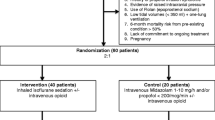Abstract
Objective
Sedation in neonates undergoing invasive prodedures as central venous catheterization (CVC) remains contro versial. Sevoflurane is an inhaled anesthetic whose periods of action and elimination are very short. The objective of this study was to evaluate the use of sevoflurane for sedation for central venous catheterization (CVC) in non-intubated neonates and preterms.
Methods
Thirty three (33) consecutive patients (range: 1–31 days old, 26 to 40 weeks GA, weighing 580 to 3200 g) were included over a 4 months period. Sevoflurane was progressively increased, until loss of consciousness and motor response to stimulation. FiO2, heart rate (HR), mean arterial pressure (MAP), duration of the procedure and the ease of the procedure were recorded.
Results
HR was very stable, but MAP dropped significantly. No patient required intubation. The ease of the procedure was scored as average 13 times and excellent 20 times.
Conclusion
The use of sevoflurane in neonates for CVC is feasible and achieve the goals of procedural sedation. The pharmacokinetic of sevoflurane enabled rapid adjustment of the depth of sedation. Sevoflurane appears to be a new agent at the disposal of neonatologists. Its use does not come without risks, especially for smaller preterms, which the treating clinician must anticipate.
Similar content being viewed by others
References
Anand KJ, Johnston CC, Oberlander TF, Taddio A, Lehr VT, Walco GA. Analgesia and local anesthesia during invasive procedures in the neonate. Clin Ther 2005; 27: 844–876.
Debillon T, Bureau V, Savagner C, Zupan-Simunek V, Carbajal R. Pain management in French neonatal intensive care units. Acta Paediatr 2002; 91: 822–826.
Nair MN, Jatana SK. Sedation analgesia in pediatric intensive care. Indian J Pediatr 2004; 71: 145–145.
Taddio A, Lee C, Yip A, Parvez B, McNamara PJ, Sha V. Intravenous morphine and topical tetracaine for treatment of pain in preterm neonates undergoing central line placement. JAMA 2006; 295: 793–800.
American Academy of Pediatrics. Committee on Fetus and Newborn. Committee on Drugs. Section on Anesthesiology. Section on Surgery. Canadian Paediatric Society. Fetus and Newborn Committee. Prevention and Management of Pain and Stress in the Neonate. Pediatrics 2000; 105: 454–461.
Simons SH, Anderson BJ, Tibboel D. Analgesic agents. In Yaffe SJ, ed. Neonatal and pediatric pharmacology. Philadelphia; Lippincott Williams and Wilkins, 2005; 638-662.
Arya V, Ramji S. Midazolam sedation in mechanically ventilated newborns: a double blind randomized placebo controlled trial. Indian Pediatr 2001; 38: 967–962.
Anand KJ, Hall RW, Desai N et al. Effects of morphine analgesia in ventilated preterm neonates: primary outcomes from the NEOPAIN randomised trial. Lancet 2004; 363: 1673–1682.
Lynn AM, Nespeca MK, Opheim KE, Slattery JT. Respiratory effects of intravenous morphine infusions in neonates, infants, and children after cardiac surgery. Anesth Analg 1993; 77: 695–701.
Simons SH, Roofthooft DW, van Dijk M et al. Morphine in ventilated neonates: its effects on arterial blood pressure. Arch Dis Child Fetal Neonatal Ed 2006; 91: F46–51.
Eger EI. Inhaled anesthetics: uptake and distribution. In Miller RD, ed. Anesthesia. Philadelphia; Churchill Livingstone, 2000; 74-95.
Agnes N. Sevoflurane sedation in infants—a fine line between sedation and general anesthesia. Paediatr Anaesth 2005; 15: 1–2.
Goa KL, Noble S, Spencer CM. Sevoflurane in paediatric anaesthesia: a review. Paediatr Drugs 1999; 1: 127–153.
Hassid S, Nicaise C, Michel F et al. Randomised controlled trial of sevoflurane for intubation in neonates. Paediatr Anaesth Accepted for publication.
Krauss B, Green SM. Sedation and analgesia for procedures in children. N Engl J Med 2000; 342: 938–945.
De Sanctis Briggs V. Magnetic resonance imaging under sedation in newborns and infants: a study of 640 cases using sevoflurane. Paediatr Anaesth 2005; 15: 9–15.
Gessler P, Cignacco E. Measures for the assessment of pain in neonates as well as a comparison between the Bernese Pain Scale for Neonates (BPSN) with the Premature Infant Pain Profile (PIPP). Klin Padiatr 2004; 216: 16–20.
Chowdhary SK, Parashar K, Buick RG, Gornall P, Corkery JJ. Central-venous access through the peripheral route in surgical neonates: an audit of 125 consecutive lines from a regional neonatal centre. Pediatr Surg Int 2001; 17: 433–435.
Friesen RH, Henry DB. Cardiovascular changes in preterm neonates receiving isoflurane, halothane, fentanyl, and ketamine. Anesthesiology 1986; 64: 238–242.
Author information
Authors and Affiliations
Corresponding author
Rights and permissions
About this article
Cite this article
Vialet, R., Michel, F., Hassid, S. et al. Sevoflurane for central venous catheterization in non-intubated neonates. Indian J Pediatr 76, 273–277 (2009). https://doi.org/10.1007/s12098-009-0012-6
Received:
Accepted:
Published:
Issue Date:
DOI: https://doi.org/10.1007/s12098-009-0012-6




